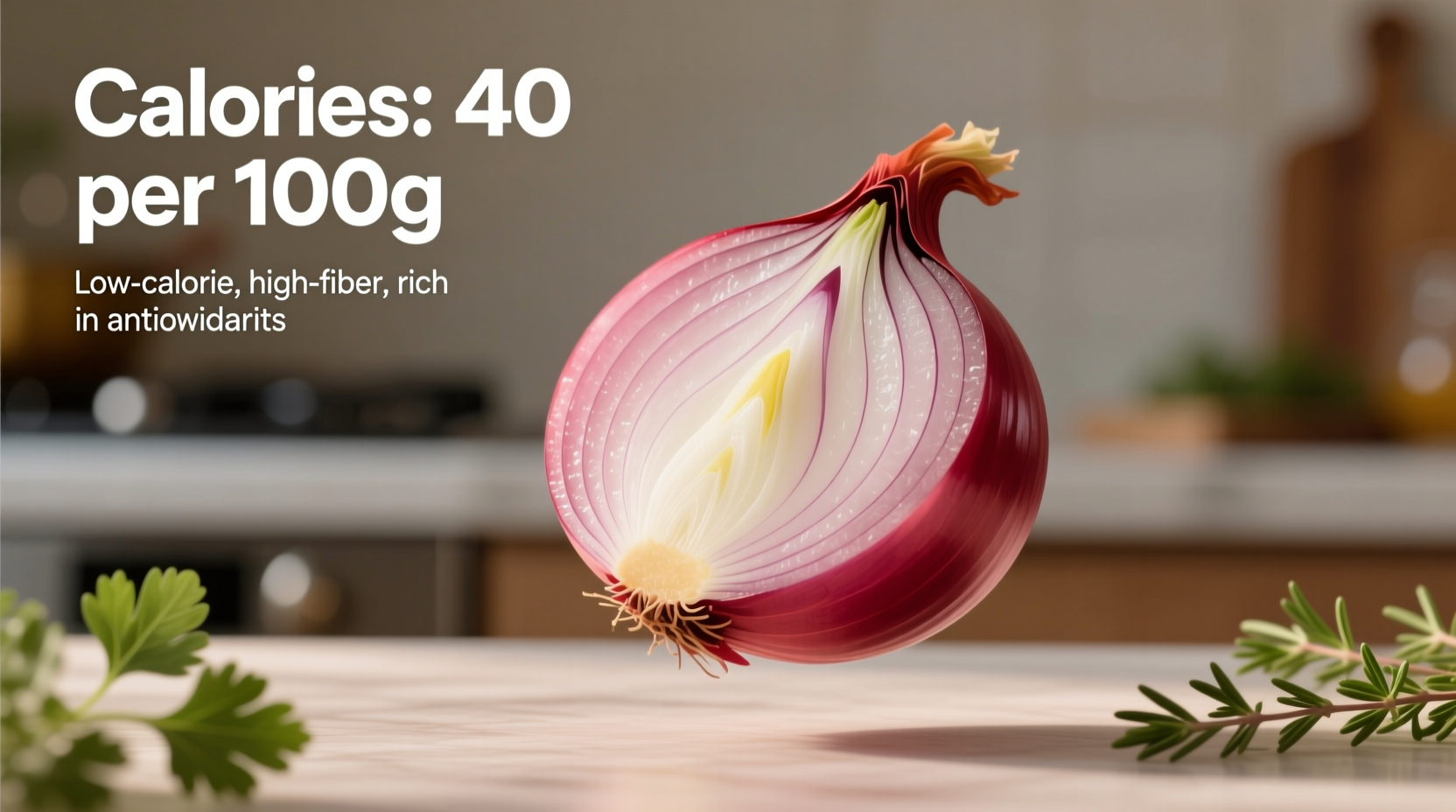Understanding the nutritional profile of common ingredients is essential for anyone tracking their dietary intake. If you're monitoring your calorie consumption or building balanced meals, knowing exactly what you're getting from staple ingredients like red onions can make a significant difference in your nutritional planning.
Red Onion Nutrition: The Complete Breakdown
When evaluating calories in a red onion, it's important to consider both the serving size and the complete nutritional picture. According to the USDA FoodData Central database, the nutritional content of red onions varies slightly based on preparation method and serving size.
| Serving Size | Calories | Carbohydrates (g) | Fiber (g) | Sugar (g) | Protein (g) |
|---|---|---|---|---|---|
| 1 medium (110g) | 44 | 10.3 | 1.9 | 5.0 | 1.2 |
| 1 cup chopped (160g) | 64 | 15.0 | 2.7 | 7.3 | 1.8 |
| 1 tablespoon (13g) | 5 | 1.2 | 0.2 | 0.6 | 0.1 |
This USDA nutritional data confirms that red onions are not only low in calories but also provide meaningful amounts of dietary fiber and essential vitamins. The carbohydrate content primarily comes from natural sugars and fiber, making red onions a smart choice for those managing blood sugar levels.
How Red Onions Compare to Other Onion Varieties
Many people wonder how calories in red onion stack up against other common onion varieties. While the differences are relatively small, they can matter when tracking precise nutritional intake:
- White onions: Slightly higher in calories (about 47 calories for a medium onion) with marginally less fiber
- Yellow onions: Very similar nutritional profile (44 calories), but with slightly higher sugar content
- Green onions (scallions): Much lower in calories (32 calories per 100g) due to higher water content
- Shallots: Higher in calories (72 calories per 100g) and carbohydrates
The minor variations in calories in different onion types primarily stem from differences in water content and sugar concentration. Red onions typically have a slightly higher water content than yellow onions, which contributes to their crisp texture and milder flavor.

Practical Applications for Calorie-Conscious Cooking
Knowing the exact calories in a red onion empowers you to make informed decisions in your meal planning. Here's how to leverage this information:
Maximizing Flavor Without Excess Calories
Red onions offer a distinctive flavor profile that can enhance dishes without adding significant calories. Their natural sweetness means you can often reduce added sugars in recipes. For example:
- Add raw red onion slices to salads for crunch and flavor (adds only 5-10 calories per serving)
- Caramelize red onions slowly to bring out natural sweetness without added sugar
- Use as a topping for burgers or sandwiches instead of higher-calorie options
- Incorporate into salsas and relishes for flavor without significant calorie impact
Meal Planning Considerations
When tracking your daily intake, remember that the calorie count for red onion changes with preparation methods:
- Raw: Lowest calorie option (44 calories per medium onion)
- Grilled or roasted: Calorie count remains similar, though water content decreases
- Fried: Significant increase in calories depending on oil absorption (can double or triple calorie count)
- Pickled: May contain added sugars that increase calorie content
For those following specific dietary patterns like keto, Mediterranean, or weight loss plans, red onions can be incorporated strategically. The CDC's dietary guidelines recommend including a variety of vegetables, and onions contribute valuable phytonutrients despite their relatively higher carbohydrate content compared to leafy greens.
Health Benefits Beyond Calorie Count
While the low calories in red onion make them attractive for calorie-conscious eaters, their nutritional value extends far beyond just being low-calorie:
- Rich in antioxidants: Particularly anthocyanins, which give red onions their distinctive color and provide anti-inflammatory benefits
- Vitamin C source: One medium red onion provides about 15% of your daily vitamin C needs
- Contains quercetin: A flavonoid with potential heart health benefits
- Prebiotic properties: The fiber in red onions feeds beneficial gut bacteria
Research published in the Journal of Nutrition and Metabolism indicates that the sulfur compounds in onions may support cardiovascular health and have anti-cancer properties. These benefits make red onions valuable beyond their modest calorie contribution.
Common Questions About Red Onion Nutrition
Understanding the calories in red onion nutrition facts often leads to related questions about incorporating them into healthy eating patterns:











 浙公网安备
33010002000092号
浙公网安备
33010002000092号 浙B2-20120091-4
浙B2-20120091-4